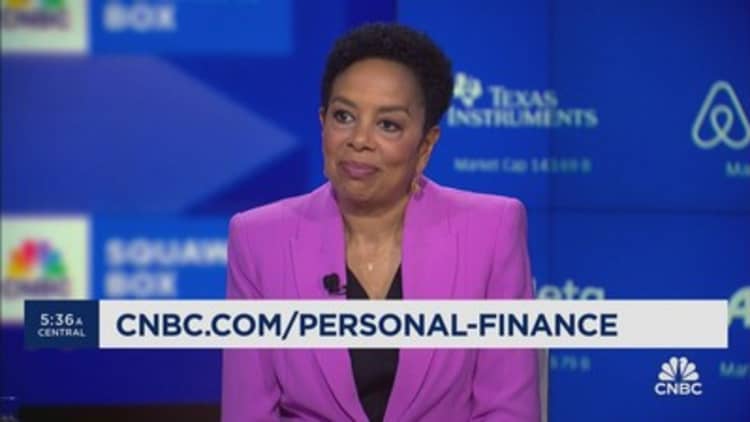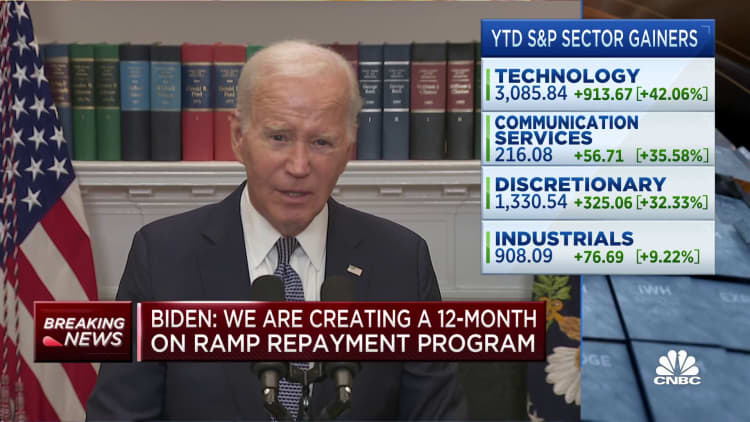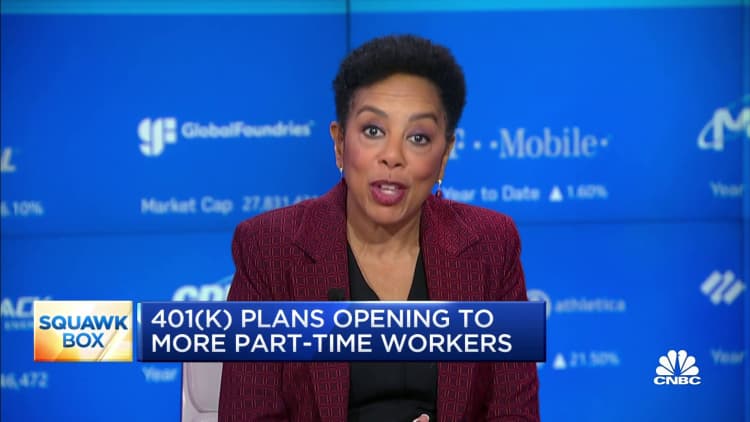Personal Finance
Here are health-care stocks to watch now, amid a bumpy recovery
Published
4 weeks agoon

The Good Brigade | Digitalvision | Getty Images
Health care, long an ailing stock market sector, has recovered over the past six months, with currently robust vital signs and strong growth projections.
The recovery comes after the sector failed to make good on positive expectations for 2022 based on estimates of pent-up demand for physician office visits and elective procedures after the pandemic.
Health care was basically flat in 2022 and again for most of 2023, a year when its overall performance was the third-worst among the market’s 11 sectors and the S&P 500 grew 26%.
Why this year may be different
Late in 2023 and in the first quarter of 2024, health-care stocks turned around, advancing about 5%, about half of the gain of the S&P 500. In mid-April, as the S&P 500 pulled back, the health-care sector gave up its first-quarter gains.
Yet, like the S&P 500, health care has gained since the market’s October low, catching some wind after two years of doldrums for the sector.
Several analysts are projecting strong performance for this year. BlackRock’s view is particularly sanguine: “Health care’s 12-month forward earnings growth is expected to lead all other sectors on a year-over-year basis.”
More from Your Money:
Here’s a look at more stories on how to manage, grow and protect your money for the years ahead.
One factor driving investment is the broadening of market performance from big tech stocks into other sectors. Amid this perennial sector rotation, health-care stocks are a natural place for money to flow now because they’re defensive, having historically done well in slowing and growing economies alike.
This defensive advantage has been drawing investment from institutional investors expecting slowing economic growth at this late stage of the business cycle, as the Federal Reserve estimates growth of 2.5% for the first quarter compared with 3% in 2023.
Constant demand
Health care is a defensive redoubt for investors because demand isn’t affected by the economy. People will always need health care, and insured people will usually seek it, regardless of what the economy’s doing.
For many individuals, a slowing economy may lead to less job security, prompting them to spend less. This may mean putting off buying a new car or remodeling the kitchen, but not medical care.
Further, demand is unflagging from baby boomers on Medicare, including those with supplemental plans with relatively low deductibles and co-pays.
Also driving the sector has been a shift in investor sentiment, with buzz surrounding new pharmaceuticals, such as GLP-1 drugs for treating diabetes and effecting weight loss, and robotic technology enabling minimally invasive techniques for complex surgeries.
GLP-1 drugs have doubled Eli Lilly’s share price over the past 12 months, bringing its trailing price-earnings, or P/E, ratio for that period to a lofty 129. Over the same period, Intuitive Surgical’s robotic da Vinci Surgical System helped the company grow its stock 42%, bringing its trailing P/E ratio to 75.
Though these two stocks may continue to do well this year, health-care companies that probably have more room to grow, as indicated by their lower valuations, aren’t scarce. They can be found in various subsectors, including biotech, providers/services, equipment/supplies and life science tools/services.
Six stocks to watch
Here are six stocks with attractive valuations, low-risk fundamentals, good earnings and strong growth projections:
- Abbvie (ABBV). This well-known biotech company has an unusually high dividend yield — currently, 3.83%. Products include drugs for treating psoriatic arthritis, plaque psoriasis, Crohn’s disease, depression and some cancers. Market cap: $286 billion. Trailing 12-month P/E ratio: 16.3.
- Vertex Pharmaceuticals (VRTX). This biotech company is a dominant player in the market for cystic fibrosis therapies. After announcing largely positive results from a clinical trial of a non-opioid acute pain drug in January, the company said it would apply for regulatory approval at midyear. The goal is to capture some of the huge market share of opioids, which carry the risk of addiction. Market cap: about $102 billion. Trailing P/E: 28.
- Stryker Corp. (SYK). This medical device company manufactures various implants for spinal conditions and joint replacements for knees, hips and shoulders. Stryker benefits from sustained demand from aging boomers with deteriorating joints. Market cap: $129 billion. Trailing P/E: 33.
- Medpace Holdings (MEDP). At 43, Medpace’s trailing P/E may seem high, but the share price has risen 63% over the last six months. A contract research organization, Medpace provides client companies with expertise and services to help them shepherd new drugs and medical devices through the different phases of development. Market cap: $12 billion.
- Iqvia Holdings (IQV). This biotech company operates at the intersection of health care and technology, providing analytics, tech solutions and clinical research services to inform decision-making at hospitals and R&D organizations. P/E: 31. Market cap: $42 billion.
- Cencora (COR). Though Cencora’s share price has risen more than 27% over the last six months, earnings growth gives this provider of pharmaceutical supply-chain solutions and services for the human and animal markets a relatively low trailing P/E — 26. Market cap: $47 billion.
Since 1952, presidential election years have been consistently positive for the overall market, especially when an incumbent is running. But health-care stocks are sometimes an exception because the sector is a political punching bag for candidates pledging to cut costs for consumers. Stock prices may dip from such rhetoric, creating buying opportunities.
Current projections indicate that investors now buying shares of health-care companies with good fundamentals and strong market positions, and holding them into 2025, may be positioned for strong gains.
— By Dave Sheaff Gilreath, a certified financial planner, and partner/founder and chief investment officer at Sheaff Brock Investment Advisors and its institutional arm, Innovative Portfolios. Sheaff Brock Investment Advisors placed #10 in CNBC’s FA100 rankings.
You may like
Personal Finance
Here are key things to know about company stock, experts say
Published
2 weeks agoon
May 4, 2024
Prasit photo | Moment | Getty Images
As employers compete to attract and retain talent, equity compensation — or an ownership stake in the company — has become a key workplace benefit.
Some 72% of companies offer some form of equity compensation to certain employees, a 2023 survey from Morgan Stanley found. That’s up from 65% in 2021.
These perks motivate employees and boost their long-term investing goals, according to the Morgan Stanley survey, which polled 1,000 U.S. employees and 600 human resource executives.
However, some “miss the opportunity” because they don’t understand it, said certified financial planner Chelsea Ransom-Cooper, chief financial planning officer for Zenith Wealth Partners in New York.
More from Personal Finance:
This job perk is like a ‘cash bonus’ — but you need a long-term strategy, experts say
Employee stock purchase plans offer ‘free money’ — but also carry complexity and risk
Treasury Department announces new Series I bond rate of 4.28% for the next six months
Here’s what to know about three popular types of stock-based compensation, experts say.
There’s potential for ‘life-changing wealth’
Many employees receive so-called stock options as part of their compensation, which are the right to buy or “exercise” company shares at a preset price within a specific timeframe.
“It’s almost iconic to grant stock options in a startup private company,” said Bruce Brumberg, editor-in-chief and co-founder of myStockOptions.com, which covers various types of equity compensation.
Startups want to create the drive and incentive of ownership culture with the potential for “life-changing wealth,” he said.
Stock options become valuable when there’s a discount between your preset price and the market value, which makes it more attractive to exercise. However, the taxes can be complicated, depending on the type of stock options.
Incentive stock options can offer some tax benefits — if you meet certain rules — but could trigger the alternative minimum tax, a parallel system for higher earners.
Photo by LanaStock via Getty Images
By comparison, the more common nonqualified stock options generally have less favorable tax treatment and you’ll owe regular income taxes on the discount upon exercise.
But even with an initial discount, there’s no guarantee a company’s stock price won’t decrease after exercising a stock option.
“It could be worth nothing but a piece of paper,” Ransom-Cooper from Zenith Wealth Partners said.
Restricted stock units are ‘like a cash bonus’
Another benefit, restricted stock units, or RSUs, are company shares granted upon hiring, which vest over time. RSUs can also be tied to performance-based goals.
Some 94% of public companies offer RSUs to at least middle managers, according to a 2021 survey from the National Association of Stock Plan Professionals.
“I like to think of it like a cash bonus,” said Pittsburgh-based CFP Matthew Garasic, founder of Unrivaled Wealth Management.
I like to think of it like a cash bonus.
Matthew Garasic
Founder of Unrivaled Wealth Management
For example, if the stock price is $10 and 100 shares vest, it’s treated like $1,000 in compensation for that year, and the standard withholding of 22% might not be enough, depending on your tax bracket, he explained.
After vesting, the decision to sell or hold RSUs depends on your short- and long-term investing goals.
“We like to establish a target of what they like to hold in company stock,” said Garasic, who aims to keep allocations of a single stock to 10% or less. “Once we get above that target, we just sell at vest.”
Employee stock purchase plans offer ‘free money’
Many publicly traded companies may also offer discounted company shares via an employee stock purchase plan, or ESPP.
“There’s free money to be had” with an ESPP, Garasic explained.
However, the decision to participate typically depends on your short-term financial goals.
After enrolling, your ESPP collects a portion of after-tax money from each paycheck and uses the funds to buy discounted company stock on a specific date.
The gold standard is a 15% discount with a lookback feature, which bases the stock purchase price on the value at the beginning or end of the offering period, whichever is lower, experts say.
Any time you’re investing in a single company, there’s certainly a big risk.
Kristin McKenna
President of Darrow Wealth Management
You can typically sell after a set period, but there’s no guarantee you’ll make money, even with the built-in discount.
“Any time you’re investing in a single company, there’s certainly a big risk,” CFP Kristin McKenna, president of Darrow Wealth Management in Boston, previously told CNBC.
Yearly goals like investing up to your employer’s 401(k) match should come before your ESPP, especially with limited income, she added.

Personal Finance
Public Service Loan Forgiveness program will go on partial pause
Published
2 weeks agoon
May 3, 2024
Teacher teaching her students in art class at school.
Fg Trade | E+ | Getty Images
The popular Public Service Loan Forgiveness program began a partial processing pause on May 1, which will likely run through July, the U.S. Department of Education recently said.
The temporary suspension comes as the Biden administration overhauls the once-troubled federal student loan program.
Here’s what borrowers should know.
Why the pause is happening
The PSLF program, signed into law by President George W. Bush in 2007, allows certain not-for-profit and government employees to have their federal student loans canceled after 10 years of on-time payments.
However, the program has been plagued by problems, making people who actually get the relief a rarity.
Borrowers often believe they’re paying their way to loan cancellation only to discover at some point in the process that they don’t qualify, usually for confusing technical reasons. Lenders have been blamed for misleading borrowers and botching their timelines.
More from Personal Finance:
Advice about 401(k) rollovers is poised for a big change. Here’s why
IRS free filing pilot processed more than 140,000 returns, commissioner says
Here’s why new home sales inch higher despite 7% mortgage rates
The Biden administration has been trying to reform the program. As part of that overhaul, it is changing how loan servicing works for public servants, and some of the customer service will soon be handled by the government itself.
“After the improvements, PSLF borrowers will have all of their PSLF information centralized on StudentAid.gov so that the Department can provide real-time and more accurate information on payment counts and form processing,” the Education Department wrote in a recent blog post.
Previously, only one company managed the servicing for PSLF borrowers on behalf of the government: first, FedLoan, and more recently, Mohela, or the Missouri Higher Education Loan Authority. Going forward, a number of different companies will service the accounts, along with the Education Department.
What borrowers can expect during the transition
The Education Department will not review PSLF form submissions for roughly a two-month period, it says. (The exact dates will depend on how long the changes take place to complete.)
Meanwhile, from May 1 through July, it says, “borrowers will not be able to see their PSLF payment counts on MOHELA’s website.”
“During the transition, PSLF forgiveness will be suspended,” said higher education expert Mark Kantrowitz.

Borrowers will be able to continue making their loan payments, and these months will count on their timeline to loan forgiveness. Borrowers should also be able to submit a form to certify public service employment and to apply for loan forgiveness if they are at the 10-year mark.
“Forms will be reviewed as soon as the transition is complete,” the Education Department says.
If you qualify for debt cancellation during the transition, you can request a forbearance from your servicer in the meantime, it says, adding that any overpayments should be refunded.
Don’t miss these exclusives from CNBC PRO
Personal Finance
Your Roth 401(k) after-tax matching contribution could trigger taxes
Published
2 weeks agoon
May 3, 2024
If you’ve opted into your employer’s Roth 401(k) after-tax matching contributions this year, it could trigger a tax surprise without proper planning, experts say.
Enacted in 2022, Secure 2.0 ushered in sweeping changes for retirement savers, including the option for employers to offer 401(k) matches in Roth accounts. These accounts are after-tax, meaning employees pay upfront taxes but growth and withdrawals in retirement are tax-free. Previously Roth 401(k) matches went into pretax accounts.
Roughly 12% of employers with 401(k) plans said they are “definitely” adding the feature and 37% are “still considering it,” according to a recent survey from the Plan Sponsor Council of America.
However, those new matching Roth contributions could have “unintended consequences” at tax time, according to Tommy Lucas, a certified financial planner and enrolled agent at Moisand Fitzgerald Tamayo in Orlando, Florida.
More from Personal Finance:
IRS aims to more than double its audit rate on wealthiest taxpayers
Here are three ways to lower your credit card annual percentage rate, experts say
Why your financial advisor may not give you the best Social Security advice
“If you go this route, you’ll want to know that you’re basically getting extra income” and taxes aren’t automatically withheld, Lucas said.
“You’re increasing your adjusted gross income by taking this match as a Roth,” he said.
“If you go this route, you’ll want to know that you’re basically getting extra income.”
Tommy Lucas
Financial advisor at Moisand Fitzgerald Tamayo
For example, let’s say your salary is $100,000 with a 6% employer match in 2024. If you designate your $6,000 employer match as Roth and you’re in the 22% federal income tax bracket, you could have an extra $1,320 in tax liability, according to Lucas.
“There’s probably something on top of that for state income taxes,” depending on where you live, he said.
Plus, you won’t see your employer’s matching Roth contribution reported on Form W-2, according to IRS guidance released late last year. Instead, you’ll receive Form 1099-R, which could be confusing, Lucas said.
How to plan for income from Roth 401(k) matches
If you’ve chosen your company’s Roth matches for 2024, you need to prepare for the extra income, said CFP Jim Guarino, managing director at Baker Newman Noyes in Woburn, Massachusetts. He is also a certified public accountant.
You can increase your federal and state withholdings with your employer or boost your quarterly estimated tax payments, he said.

For example, if you expect to incur $1,320 more in federal taxes, you could divide that amount by your remaining 2024 paychecks and include that “extra withholding” on Form W-4 for your employer, Lucas said.
Of course, you’ll need to double-check that the change is reflected on future paychecks, he said.
“In either case, working with a trusted tax advisor would help to optimize overall tax planning and eventual tax reporting for the year,” Guarino added.
Don’t miss these exclusives from CNBC PRO

Betting on the Kentucky Derby? Here’s how to think like a professional handicapper.

Warren Buffett says Greg Abel will make Berkshire Hathaway investing decisions when he’s gone

EV makers win 2-year extension to qualify for tax credits

Are American progressives making themselves sad?

‘Best Firms for Tech’ 2024 deadline extended to April 10

